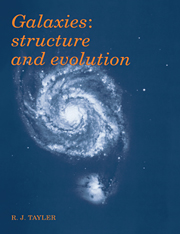Book contents
- Frontmatter
- Contents
- Preface
- Symbols
- Numerical values
- 1 Introduction
- 2 Observations of the Galaxy
- 3 Properties of external galaxies
- 4 Stellar dynamics
- 5 Masses of galaxies
- 6 The interstellar medium in our Galaxy
- 7 The chemical evolution of galaxies
- 8 Galaxies and the Universe
- 9 Concluding remarks
- Appendix 1 Some factors influencing stellar spectra
- Appendix 2 The Virial Theorem
- Appendix 3 Gravitational fields due to spheres and ellipsoids
- Suggestions for further reading
- Index
2 - Observations of the Galaxy
Published online by Cambridge University Press: 05 June 2012
- Frontmatter
- Contents
- Preface
- Symbols
- Numerical values
- 1 Introduction
- 2 Observations of the Galaxy
- 3 Properties of external galaxies
- 4 Stellar dynamics
- 5 Masses of galaxies
- 6 The interstellar medium in our Galaxy
- 7 The chemical evolution of galaxies
- 8 Galaxies and the Universe
- 9 Concluding remarks
- Appendix 1 Some factors influencing stellar spectra
- Appendix 2 The Virial Theorem
- Appendix 3 Gravitational fields due to spheres and ellipsoids
- Suggestions for further reading
- Index
Summary
Introduction
This chapter contains a description of the properties of the Galaxy. It is concerned mainly with obervations, although as I have mentioned on page 18 many of the observations require a considerable amount of interpretation before they are very useful. The Galaxy is primarily a system of stars and I start this chapter by summarising some of the properties of stars of different types. As I shall explain later, there is some considerable uncertainty about the total mass of the Galaxy and about the masses of its individual components. In particular we shall learn that much of the mass of our own Galaxy and other galaxies may be invisible. Although this hidden matter might be very low luminosity stars or dead stellar remnants, there is a general belief that it is composed of weakly interacting elementary particles. At present I shall concentrate attention on the visible components. For them it may not be too far wrong to suppose that 95 per cent of the mass is stellar (including dead remnants) and about 5 per cent is in the form of interstellar gas and dust. In addition the Galaxy contains cosmic rays, very high energy charged particles, which contribute very little to the total mass but whose total energy is very important in discussions of the structure of the interstellar medium, as we shall see in Chapter 6.
- Type
- Chapter
- Information
- GalaxiesStructure and Evolution, pp. 20 - 51Publisher: Cambridge University PressPrint publication year: 1993



